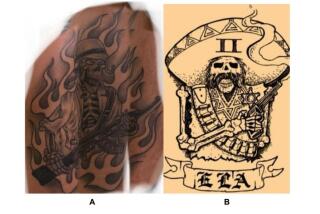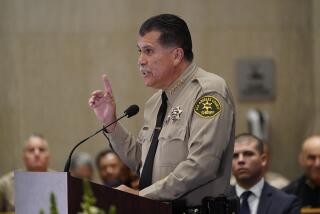Slaying reveals clashing views of Hawaiian Gardens’ sweeping gang injunction

- Share via
Johnny Ray Anderson was fixing a bicycle in the driveway of an abandoned house in Hawaiian Gardens when he saw a sheriff’s patrol car stop in the street.
He immediately fled, hopping a wall into a neighboring backyard.
As Anderson approached a side gate, a deputy peered over from the other side and fired a single shot. Anderson, 43, was struck in the chest and killed.
Conflicting accounts of what happened have emerged. The Sheriff’s Department says Anderson was shot when he tried to grab the deputy’s gun. But an attorney for Anderson’s family says blood and other physical evidence show he was too far away to have reached for the gun.
More than two months later, the fatal shooting has resurrected long-simmering complaints in the southeast L.A. County town that a years-long crackdown on gang members has gone too far and resulted in harassment of residents. An injunction imposed on Hawaiian Gardens’ dominant gang after the killing of a sheriff’s deputy a decade ago now applies to nearly 400 of the city’s 14,000 residents.
Anderson was twice convicted of violating the injunction, and his family says he was fearful of returning to jail when he decided to run from deputies before he was shot.
In an unusual move, City Council members last month voted to ask for an FBI investigation into the July 5 shooting.
Mayor Barry Bruce, who spearheaded the request, argues that the killing has rekindled distrust in the Sheriff’s Department. He says the gang injunction, which imposes a curfew and prohibits riding bicycles in public or congregating on street corners, is overly broad and has resulted in sheriff’s deputies targeting the innocent as well as the guilty.
Other residents say they have seen sheriff’s deputies cracking down on gang members for minor infractions, such as jaywalking, or for nothing at all — and they approve. Their first priority, they say, is safer streets.
“For me and my family, it’s great because it makes us feel safe,” Emanuel Nicolas, 41, said recently on the street where Anderson was shot. “But sometimes they do get harassed.”
The city’s struggle with crime has long belied its idyllic-sounding name, whose origins date to a bamboo shack covered with palm trees that served as a restaurant for travelers passing through the area on horseback. Today, the main attraction in the mostly working class, Latino suburb along the 605 Freeway is the Hawaiian Gardens Casino, which dominates the landscape and the local economy.
The city also is home to a notorious gang: Varrio Hawaiian Gardens. VHG, as it is sometimes known, has been implicated in killings, drugs and weapons trafficking, extortion and racially motivated attacks designed to drive African Americans from their homes.
One of the gang members fatally shot Deputy Jerry Ortiz in 2005. Jose Luis Orozco, who had devil horns tattooed on his forehead, received a death sentence for Ortiz’s killing. His fellow gang members were hit with the injunction, and in 2009, 147 members and associates were charged in a massive federal racketeering case. At the time, the FBI claimed 1 in 15 residents in Hawaiian Gardens had ties to the gang.
Despite the crackdown, VHG is still going strong and is currently at war with gangs in neighboring communities such as Artesia, said Capt. Keith Swensson, who runs the Lakewood sheriff’s station.
Crime has shot up in Hawaiian Gardens recently, with violent and property crimes up 78% from last year and 42% from five years ago. In 2015, aggravated assaults have increased 106%, burglaries 127% and larcenies 114%.
The uptick in assaults may have to do with increased gang activity, Swensson said. But he blamed the property crime increases on other lower-level offenders.
Still, Swensson said, the situation has improved from the days when he drove a patrol car as a deputy in the 1980s and 1990s. Back then, residents were scared to walk down the street because they might encounter a group of gang members. Swensson said that even as an armed law enforcement officer he felt scared driving around by himself in the early mornings.
From 2005 to 2014, violent crime by gang members dropped 74% in the city, compared with a 62% drop in overall violent crime. In 2005, half of violent crimes in Hawaiian Gardens were committed by gang members. The figure last year was 35%.
The injunction is targeting the right people, Swensson said, noting that to be added to it a person has to admit that he or she is in the gang or show an obvious sign of gang association such as a gang tattoo. The prohibition against gang members congregating in public has been instrumental in making residents feel safer, he said.
“The gang’s sole purpose was intimidation,” Swensson said. “They would congregate together and prey upon the innocent. That’s exactly what has ceased. One person by themselves is not as intimidating.”
Inside the Mexican restaurant she and her husband own, Francisca Aguero remembers how things were before the gang injunction. She requested that her business not be named for fear of gang retaliation.
“There were a lot of gang shootings and robberies,” Aguero, 54, said over coffee and a tamale. “We still have those problems, but they don’t happen as much.”
After the deputy was killed, the Sheriff’s Department “came down hard on the area,” Aguero recalled. She said the department was quick to descend on hotspots to put a stop to crimes such as armed robberies. Gradually, the gang shootings subsided, she said.
“Things are calm now,” she said. “I think the injunction worked — I hope it did.
“But that’s why I can’t say anything bad about the police,” she added. “They’re doing a good job.”
The city’s mayor does not agree. In a letter to Rep. Linda Sanchez (D-Whittier) requesting the FBI investigation, Bruce wrote that residents had complained that sheriff’s deputies violated their civil rights and that he did not trust local officials to investigate Anderson’s killing.
While the gang injunction has been useful in rounding up dangerous people, it has cast too wide a net, catching many “dolphins” as well as “sharks,” Bruce said in an interview.
“The department, the way they treat people in the community, it’s like everyone is a gangster in Hawaiian Gardens. No one’s a regular person,” said Bruce, who runs a ministry for at-risk youth. “It shows contempt and a prejudicial attitude towards the community.”
The city pays the Sheriff’s Department more than $3 million a year to patrol its streets. In the past, Bruce has threatened to contract with a different agency or start a city police department. While there is currently no plan to switch, Bruce noted that a new casino is in the works and would bring extra revenue that could make the city’s own police department “a very plausible idea.”
“I’d rather work with the Los Angeles County Sheriff’s Department if they can be more transparent and more concerned about the things their officers are involved in,” Bruce said.
At a City Council meeting last month, three other council members supported the mayor’s call for a federal investigation, though two of them balked at the critical tone of Bruce’s letter and said they would write their own to Sanchez. Councilman Michael Gomez objected, saying in a letter that was read aloud that the council should be a “calming influence and reduce tension and tempers rather than fan flames” at a time when law enforcement is being criticized across the country.
Swensson said he is not opposed to having the FBI examine Anderson’s killing.
Meanwhile, Anderson’s family is grieving. He was married and had seven children.
His wife, Kathleen Anderson, said she and her husband had been homeless for several months after moving back to Hawaiian Gardens from Iowa, where they had jobs but found the cold weather unbearable.
Court records show Anderson had a long criminal history stretching to the mid-’90s, mostly for drug and property crimes.
A family attorney recently released details of an independent autopsy that concluded there was no gun residue on Anderson’s body. Blood splatter on the corner end of a shed next to the gate indicated that he was standing about six feet away from the deputy, attorney Arnoldo Casillas said. He said the evidence shows Anderson was not close enough to the deputy to be trying to grab his gun.
According to Casillas, at least three witnesses saw the deputy trying to scale a gate by hoisting himself up while gripping his gun with the same hand.
The Sheriff’s Department declined to speak further about the shooting because the investigation is ongoing.
The 13-year veteran deputy who shot Anderson remains with the Lakewood sheriff’s station but is no longer patrolling Hawaiian Gardens, Swensson said. Sheriff’s officials have not released the deputy’s name, claiming that his safety would be jeopardized, though they refused to specify the threat. The Los Angeles County coroner has not released autopsy results.
Anderson’s sister, Francine Trevino, teared up as she spoke about Anderson at the recent council meeting where the mayor called for an FBI investigation.
“Every morning I wake up without a brother,” Trevino told the council.
[email protected]
Twitter: @latvives
[email protected]
Twitter: @cindychangLA
ALSO
Judge orders lawyer to jail for contempt of court in L.A. Unified case
Suit to limit use of teacher union dues for political purposes is tossed
LAPD defends officers who purchased discounted guns
More to Read
Sign up for Essential California
The most important California stories and recommendations in your inbox every morning.
You may occasionally receive promotional content from the Los Angeles Times.












